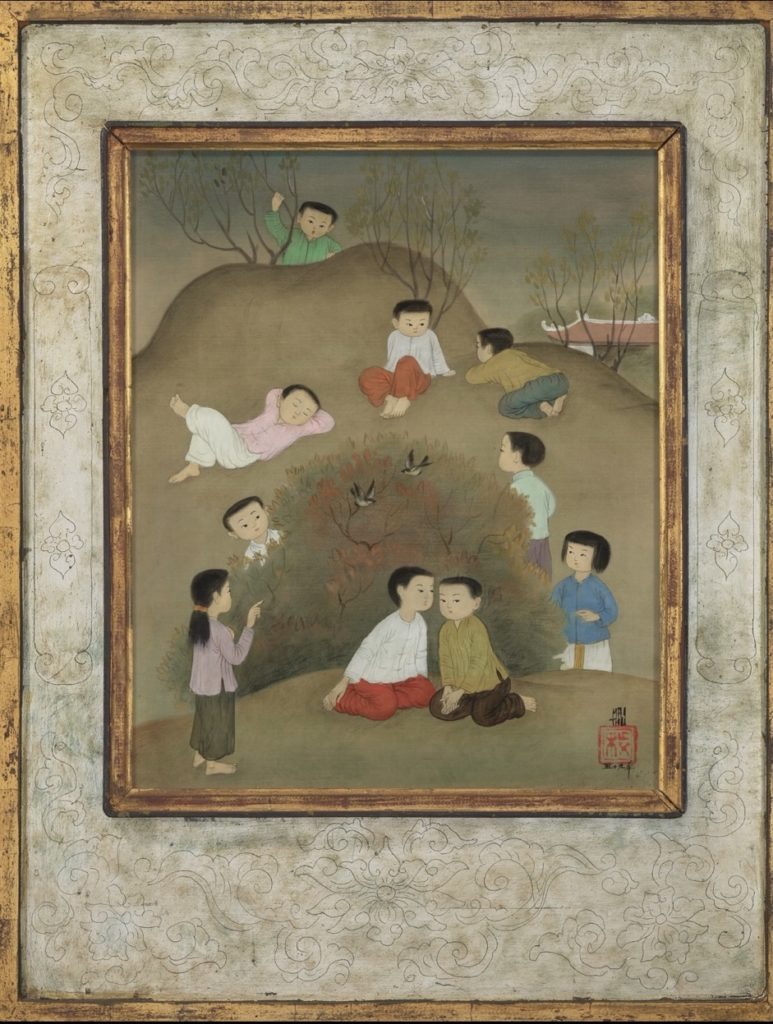Mai Thu, 1959, « Les Enfants » (Children), or the certainty of hope
We are honored to present a breathtaking work by Mai Thu.
In 1959, the year of our painting, the 53 years old painter is entitled to draw up a positive evaluation of his 22 years of continuous presence in France.
Since 1937, he has exhibited in Paris, notably at the AGINDO, the Salon des Indépendants, but also in renowned private galleries such as Hessel, Roux-Hentschel and Conti, among others. Outside of the capital, his works were seen notably in French Algeria, in Oran and Algiers, in the Pasteur and Romanet galleries or in Vichy at the Lorenceau gallery.
These successful exhibitions allowed him to be known among collectors who appreciated his work since the 1931 Paris Colonial Exhibition. Reinforcing connection with those who already discovered him earlier in Vietnam through the promotional efforts of the Hanoi School of Fine Arts. State purchases in 1940 (“Scène de la vie annamite”) and 1941 (“La musique”) brought him a little more support from the public power so dear to the French. Married in 1954, father in 1956, Mai Thu, probably emotionally fulfilled, strengthened himself professionally: the previous year (June 10) he signed an exclusive contract with the gallery owner Jean-François Apestéguy who would guide his career admirably. A much appreciated musician, the following year the painter won an important “Grand Prix du disque” (with Tran Van Khê) for “Musique du Vietnam”.
Yes, in this year 1959, Mai Thu is an enthusiastic artist and a serene man.

Enthusiasm and serenity that burst in “Les enfants” (Children), a rare work, not only subtle but joyful.
Children, that is. Eight boys and two girls.
But also two birds, face to face, one on a branch, the other in flight.
Four or six (so tangled) shrubs, one bushy in the foreground, the others further away, tenuous.
A flat, a hollow and then a main hill and a hillside, all arranged in several levels aligned to the roof of a house in the background.
A small nod to Chinese painting, Mai Thu places the bushy shrub and some of the children at our level of vision, raising the horizon line but not high enough to make the sky disappear. Just a wink as it is the house that closes the horizon.
The large format of the work, its background in several shades of brown, the sober colors of the gouache used for the clothes, the ink of the hair, the faces, expressive, very carefully painted, formalize the message of the artist: from this grouping of miniatures – each of these children could constitute an autonomous work of the painter – which founds a sumptuous whole, emanates a strong vision subtly enlightened by the expressions of the faces and the postures of the children.
Girls and boys are not “dressed up” in their usual costume – which the painter often represented – but soberly.
They are not the children of war either, with emaciated features and distressed postures usually described by the painter as early as 1954 at the end of the first Indochina war and the partition of the country, and then, later, gleaning the tragedy of this civil war and its innocent victims for whom he would constantly express extreme compassion.
Nor are they associated with the accessories that the painter often likes to describe meticulously. No brushes, pens, books, inkwells, vases, furniture, hangings, games, musical instruments, fans, baskets. And our list is not closed…
Not even that hushed, interior, often languid atmosphere that he loves.
In this open air, there are no adults either. No sister or caring mother, no respected grandparents.
No intermediaries. Neither material, nor human.
No, the subject is the children. Purely them. Immediate.
The colors of the set giver order to a triple geometric oval – rectangle – triangle. The oval is the whole group, the rectangle is the tunics and light-colored pants, and the triangle is the ink of the hair. A construction that Nguyen Phan Chanh, his fellow student at the Hanoi School of Fine Arts, were particularly fond of. Mai Thu organises the scene around the two birds, the almost central point of the work. And thus “forces” us to concentrate and to take in his message.
Let us observe the children from top to bottom and from left to right within the four layers materialized by the artist.
The following are successively illustrated: questioning discovery, sleep (dream?), perceptive attention, persuasion, attentive observation, distant observation, naming, affirmation, listening, questioning.
Note that the two little girls – a minority in this very masculine group, but Mai Thu is also a Confucian… – are addressing each other, one pointing her finger at the birds as to point them out to the other who already stares at them.
The boys interact because each of these activities is nothing without one of the others.
Here are the noblest activities of human being when dedicated to observation, to reflection, to dialogue. When it embodies humanism.
The frame executed by the artist comes – by its double golden net – as if to set the painted silk and – by its silver coloring in flat areas with floral and vegetal decoration – to enhance its luminosity by underlining the light-colored elements (tunics and pants of the children and portions of the wall and roof of the house).
Mai Thu wants to tell us, because he believes it, because otherwise nothing is worth living, that the world will be saved by its youth.
Like the certainty of hope.
But if 1959 could and should be the year of hope, the years that followed will come with an accumulation of torments. Mai Thu does not know it yet, but of “his” children of 1959, all will suffer in the homeland of Vietnam. A fratricidal war would take place far from him.
These (his) children, how did they experience it?
Jean-François Hubert